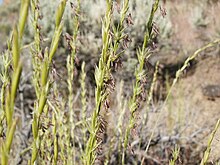Pseudoroegneria spicata
| Bluebunch wheatgrass | |
|---|---|
 |
|
| Scientific classification | |
| Kingdom: | Plantae |
| (unranked): | Angiosperms |
| (unranked): | Monocots |
| (unranked): | Commelinids |
| Order: | Poales |
| Family: | Poaceae |
| Genus: | Pseudoroegneria |
| Species: | P. spicata |
| Binomial name | |
|
Pseudoroegneria spicata (Pursh) Á.Löve 1980 |
|
| Synonyms | |
|
List
|
|
Pseudoroegneria spicata is a species of grass known by the common name bluebunch wheatgrass. This native western North American perennial bunchgrass is known by the scientific synonyms Elymus spicatus and Agropyron spicatum. The grass can be found in the United States, Canada, and Mexico from Alaska and Yukon south as far as Sonora and Nuevo León.
Bluebunch wheatgrass can often be distinguished from other bunchgrasses by the awns on its seedheads which stand out at an angle nearly 90 degrees from the stem. It is often bluish. The roots of the grass have a waxy layer that helps it resist desiccation in dry soils. In areas with more moisture the grass may produce rhizomes.
The relationship between the traits and climates of P. spicata is consistent with those of other grass species that also have a summer growing season. Populations of P. spicata from warm, arid environments are often smaller with earlier phenology, narrower leaves, and have greater leaf pubescence. This is in contrast to P. spicata plants from wetter and higher nutrient environments, which tend to be bigger, taller, and have larger leaves.
The stems and leaf sheaths of P. spicata dominate photosynthetic carbon uptake during the late spring and summer seasons. Additionally, bluebunch wheatgrass shows a greater investment of biomass and nutrients in the stems and sheaths, causing an increase in photosynthetic capacity per unit surface area.
Pseudoregneria spicata has extensive drought resistant root systems that can compete with and suppress the spread of exotic weeds. Its roots are also known to have significant responses when they come into contact with the roots of other plants. When plants of the same species that were grown in different sites were planted in pots together, the resulting biomass was 30% more than in pots with plants from the same population or site. Furthermore, the elongation of the roots decreased after contact with roots from another plant from the same population, this was compared to after contact with roots from a plant of a different population. Such behavior suggests that the roots of bluebunch wheatgrass are capable of detection and avoidance mechanisms when exposed to intraspecific plants from the same population.
...
Wikipedia
